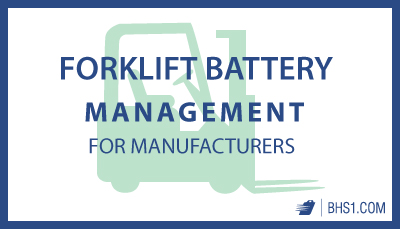We use cookies to make your experience better. To comply with the new e-Privacy directive, we need to ask for your consent to set the cookies. Learn more.
Forklift Battery Management for Manufacturers
The manufacturing industry can’t operate without adequate material handling systems, and, inevitably, those systems include forklifts. From replenishment to handling pallets of raw goods and finished products, forklifts provide the muscle that keeps manufacturing lines running.

It comes as something of a surprise, then, that manufacturing facilities don’t always apply the same engineering interventions that they use to keep lines humming along efficiently. Industrial engineers may spend months devising a new process or production pathway; meanwhile, forklift batteries lie stacked and leaking in the corner of the facility.
New data-collection and monitoring systems are now applying data-driven insights into forklift battery management processes. Manufacturing operations that adopt these solutions will enhance competitiveness, cut operating costs, and come closer to the ideals set forth in the lean manufacturing philosophy. Here’s why every manufacturer that runs a fleet of electric forklifts should invest in battery management tools as soon as possible:
- Battery management hasn’t yet caught on in the manufacturing industry, giving early adopters a powerful competitive edge. Industry publication Modern Materials Handling reports that somewhere around 20 percent of industrial battery users manage assets with smart fleet-management tools. That leaves 80 percent of battery-using competitors likely stuck with inefficient battery management; we’d call that an opportunity to get ahead.
- Smart battery management allows users to right-size battery fleets for further cost savings. Each battery in the fleet creates maintenance and storage costs. Essentially, owning more batteries than you need is a clear drain on resources. When battery owners use fleet-management systems that track usage data and provide detailed reporting, they can accurately slim battery holdings down to precisely the right number. Fleet Tracker provides just this capability.
- The same is true of forklift battery chargers; properly managed, operators who use fleet management tools can get more results with fewer units. When users have an accurate picture of battery use, they can match battery and charger stores to cut operating and purchasing costs.
- Monitoring batteries can prevent early burn-out and extend the working life for the entire fleet. Perhaps the most powerful feature of fleet-management tools is that they tell operators which batteries to choose. This prevents forklift operators from favoring certain batteries, burning them out quickly while others deteriorate in corner stands.
- Fleet-management systems boost compliance with battery maintenance protocols. Fleet Tracker tracks maintenance tasks like cleaning, watering, and equalization charges. With a detailed, automatic record of these necessary jobs, users will never miss a maintenance task again.
Here’s an interesting question for the manufacturing industry: Why all the focus on electric forklifts, rather than LPG or IC models?
Increasingly, forklift batteries are the motive power solution of choice for forklift users in the manufacturing industry. Electric forklifts are emissions-free, so they contribute to green manufacturing initiatives. They’re also cleaner than IC trucks, so they’re suitable for facilities that handle sensitive materials, such as foods, electronics, and medical equipment.
In fact, the unique demands of manufacturers contribute to the rise of the electric forklift, which has comprised two-thirds of the overall forklift market in the United States more often than not over the past decade. Considering this fact, forklift battery management is as crucial as any cost-saving strategy in the modern manufacturing facility.
References:
“Alliance of Industrial Truck Organizations President’s Forum.” IndTrk. Industrial Truck Association, 26 Sept. 2017. PDF. 27 Nov. 2018.
Bond, Josh. “Lift truck battery management delivers staying power.” MMH. Peerless Media LLC, 13 Mar. 2018. Web. 27 Nov. 2018.
